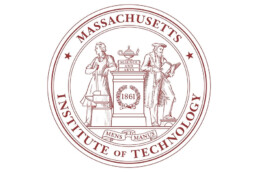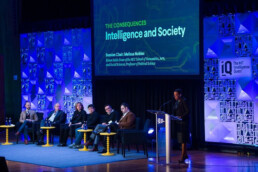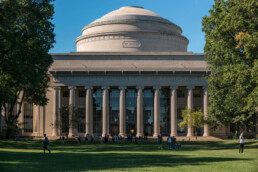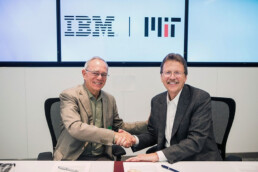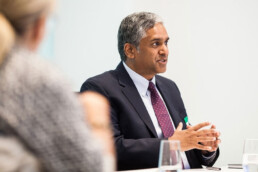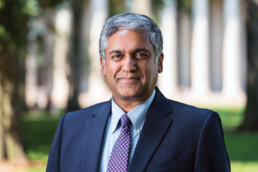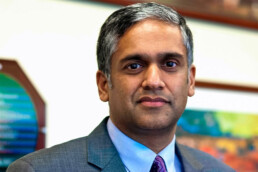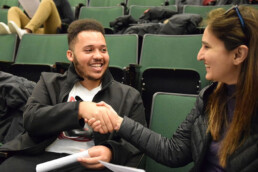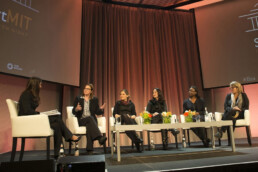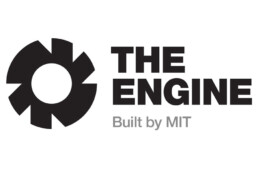Letter regarding The Engine Working Groups final report
Ultra-low-power sensors carrying genetically engineered bacteria can detect gastric bleeding.
The following email was sent today to the MIT community by Provost Martin A. Schmidt.
To the members of the MIT community:
I am writing to share the final report of The Engine Working Groups.
At the beginning of last year, I charged five MIT working groups and an advisory committee, led by School of Engineering Dean Anantha P. Chandrakasan, to guide the development of Institute policies and procedures for engaging with The Engine. The Engine, an external innovation accelerator, was launched by MIT to help start-ups working on capital- and time-intensive technologies access long-term funding, workspaces, equipment, services, and entrepreneurial expertise needed to bring their ideas from inception to the marketplace. The official opening of The Engine took place in September.
Sixty-two members of the MIT community, including faculty, students, postdocs, and staff, have participated in this effort organized around the following working groups: 1) Facilities Access, chaired by Professor Martin Culpepper; 2) New Models for Technology Licensing, chaired by Professor Timothy Swager; 3) Conflict of Interest, chaired by Professor Klavs Jensen; 4) Visas for MIT Entrepreneurs, chaired by Professor Dick Yue; and 5) MIT’s Innovation Ecosystem, co-chaired by Professors Vladimir Bulović and Fiona Murray.
I shared a preliminary report with the community in June and have since received additional input and feedback from faculty, students, and staff. This final report includes recommendations based on months of activity, including campus-wide engagement, such as a forum on the preliminary recommendations last spring and a session during the faculty meeting this past October. I have reviewed the report’s findings with President Rafael Reif, Vice President for Research Maria Zuber, and Executive Vice President and Treasurer Israel Ruiz.
We have prioritized the recommendations and developed an implementation framework that will be facilitated by the MIT Innovation Initiative and its co-directors, Professors Michael Cima and Fiona Murray. Key activities include the creation of a function within the MIT Innovation Initiative to oversee the overall interface between MIT and The Engine, the development of new standard agreements for technology licensing and intellectual property (IP), the formation of an Institute-level Conflict of Interest committee, engagement through the Boston University Entrepreneurship and IP Law Clinic to help international entrepreneurs obtain legal advice on immigration matters, and the creation of a pilot master’s of innovation degree that provides students a clear program of innovation and entrepreneurial offerings—including The Engine—and allows international students to pursue entrepreneurial endeavors.
I am grateful to Professors Cima and Murray for their leadership of this next phase, and as we move forward with implementation, we will continue to look to the MIT community for input and feedback.
I would like to extend my sincere gratitude to Dean Chandrakasan, the Advisory Committee, and the Working Group chairs and members for their creative insights, ideas, and hard work. I am eager to see how these ideas will allow MIT and The Engine help young companies develop transformative innovations toward making a better world.
Sincerely,
Martin A. Schmidt
MIT Intelligence Quest kicks off
A star-studded lineup helps the Institute celebrate the launch of a new initiative on human and machine intelligence.
“In the history of science and technology, there are moments of opportunity,” MIT President L. Rafael Reif told a packed Kresge Auditorium on March 1. “Moments when the tools, the data, and the big questions are perfectly in sync. In the field of intelligence, I believe this is just such a moment.”
MIT faculty and friends helped the Institute celebrate the launch of a new initiative on human and machine intelligence, with a star-studded lineup of speakers from the interlocking realms of artificial intelligence, cognitive science, neuroscience, social sciences, and ethics.
MIT and SenseTime announce effort to advance artificial intelligence research
Alliance will be part of new MIT Intelligence Quest.
MIT and SenseTime today announced that SenseTime, a leading artificial intelligence (AI) company, is joining MIT's efforts to define the next frontier of human and machine intelligence.
SenseTime was founded by MIT alumnus Xiao’ou Tang PhD ’96 and specializes in computer vision and deep learning technologies. The MIT-SenseTime Alliance on Artificial Intelligence aims to open up new avenues of discovery across MIT in areas such as computer vision, human-intelligence-inspired algorithms, medical imaging, and robotics; drive technological breakthroughs in AI that have the potential to confront some of the world’s greatest challenges; and empower MIT faculty and students to pursue interdisciplinary projects at the vanguard of intelligence research.
Neural networks everywhere
New chip reduces neural networks’ power consumption by up to 95 percent, making them practical for battery-powered devices.
Most recent advances in artificial-intelligence systems such as speech- or face-recognition programs have come courtesy of neural networks, densely interconnected meshes of simple information processors that learn to perform tasks by analyzing huge sets of training data.
But neural nets are large, and their computations are energy intensive, so they’re not very practical for handheld devices. Most smartphone apps that rely on neural nets simply upload data to internet servers, which process it and send the results back to the phone.
Now, MIT researchers have developed a special-purpose chip that increases the speed of neural-network computations by three to seven times over its predecessors, while reducing power consumption 94 to 95 percent. That could make it practical to run neural networks locally on smartphones or even to embed them in household appliances.
Energy-efficient encryption for the internet of things
Special-purpose chip reduces power consumption of public-key encryption by 99.75 percent, increases speed 500-fold.
Most sensitive web transactions are protected by public-key cryptography, a type of encryption that lets computers share information securely without first agreeing on a secret encryption key.
Public-key encryption protocols are complicated, and in computer networks, they’re executed by software. But that won’t work in the internet of things, an envisioned network that would connect many different sensors — embedded in vehicles, appliances, civil structures, manufacturing equipment, and even livestock tags — to online servers. Embedded sensors that need to maximize battery life can’t afford the energy and memory space that software execution of encryption protocols would require.
MIT researchers have built a new chip, hardwired to perform public-key encryption, that consumes only 1/400 as much power as software execution of the same protocols would. It also uses about 1/10 as much memory and executes 500 times faster. The researchers describe the chip in a paper they’re presenting this week at the International Solid-State Circuits Conference.
IBM and MIT to pursue joint research in artificial intelligence, establish new MIT-IBM Watson AI Lab
IBM plans to make a 10-year, $240 million investment in new lab with MIT to advance AI hardware, software, and algorithms.
IBM and MIT today announced that IBM plans to make a 10-year, $240 million investment to create the MIT–IBM Watson AI Lab in partnership with MIT. The lab will carry out fundamental artificial intelligence (AI) research and seek to propel scientific breakthroughs that unlock the potential of AI. The collaboration aims to advance AI hardware, software, and algorithms related to deep learning and other areas; increase AI’s impact on industries, such as health care and cybersecurity; and explore the economic and ethical implications of AI on society. IBM’s $240 million investment in the lab will support research by IBM and MIT scientists.
The new lab will be one of the largest long-term university-industry AI collaborations to date, mobilizing the talent of more than 100 AI scientists, professors, and students to pursue joint research at IBM's Research Lab in Cambridge, Massachusetts — co-located with the IBM Watson Health and IBM Security headquarters in Kendall Square — and on the neighboring MIT campus.
3Q: Anantha Chandrakasan on new MIT–IBM Watson AI Lab
Lab seeks to expand the boundaries of research on artificial intelligence.
MIT and IBM jointly announced today a 10-year agreement to create the MIT–IBM Watson AI Lab, a new collaboration for research on the frontiers of artificial intelligence. Anantha Chandrakasan, the dean of MIT’s School of Engineering, who led MIT’s work in forging the agreement, sat down with MIT News to discuss the new lab.
Q: What does the new collaboration make possible?
A: AI is everywhere. It’s used in just about every domain you can think of and is central to diverse fields, from image and speech recognition, to machine learning for disease detection, to drug discovery, to financial modeling for global trade.
This new collaboration will bring together researchers working on the core algorithms and devices that make such applications possible, enabling the pursuit of jointly defined projects. We will focus on basic research and applications, but with new resources and colleagues and tremendous access to real-world data and computational power.
The project will support many different pursuits, from scholarship, to the licensing of technology, to the release of open-source material, to the creation of startups. We hope to use this new lab as a template for many other interactions with industry.
We’ll issue a call for proposals to all researchers at MIT soon; this new lab will hope to attract interest from all five schools. I’ll co-chair the lab alongside Dario Gil, IBM Research VP of AI and IBM Q, and Dario and I will name co-directors from MIT and IBM soon.
Anantha Chandrakasan named dean of School of Engineering
Head of Department of Electrical Engineering and Computer Science will succeed Ian Waitz.
Anantha P. Chandrakasan, the Vannevar Bush Professor and head of the Department of Electrical Engineering and Computer Science (EECS), has been named dean of MIT’s School of Engineering, effective July 1. He will succeed Ian A. Waitz, the Jerome C. Hunsaker Professor of Aeronautics and Astronautics, who will become MIT’s vice chancellor.
During his six-year tenure as head of MIT’s largest academic department, Chandrakasan spearheaded a number of initiatives that opened opportunities for students, postdocs, and faculty to conduct research, explore entrepreneurial projects, and engage with EECS.
Anantha Chandrakasan hosts Apple CEO Tim Cook at The Engine
MIT students present their work to Apple CEO Tim Cook
Two minutes. Maybe three. That’s all students had in which to deliver the juiciest highlights of their work to MIT commencement speaker and Apple CEO Tim Cook. But on the day before he would address 2017 graduates, Cook was whipping across campus to several meetings to soak in what makes MIT unique.
As the afternoon sun burnished Massachusetts Avenue, Cook walked into a conference room at MIT’s startup accelerator The Engine, where the students were waiting. Representing diverse programs across campus, the seven presenters somehow squeezed their accomplishments into the allotted time.
“So impressed by @MIT students & faculty who are finding new ways to tackle the world’s biggest challenges,” Cook said on Twitter. “Thanks for sharing your work!”
MIT pilots full-credit online residential course
Campus students report more flexibility, reduced stress in taking an online version of a popular MIT course.
Last fall, the Department of Electrical Engineering and Computer Science (EECS) and MIT Office of Digital Learning piloted a full-credit online course for a small cohort of residential students. The popular 6.002 (Circuits and Electronics) was offered as 6.S064, leveraging an existing massive open online course (MOOC) available via the edX platform and adding a private discussion forum for MIT students.
The Teaching and Learning Lab conducted an assessment of this pilot, which is now published as an internal working paper. This preliminary assessment suggests that there are benefits to an online-while-on-campus course format. Specifically, the students who completed 6.S064 reported more flexibility with scheduling and less overall stress relative to their traditional classes. While the findings are based upon a small sample, the pilot bodes well for the possibility of allowing more student choice in how and when they learn.
The Engine closes its first fund for over $150 million
MIT’s new accelerator will now focus on selecting startups.
Just months after its launch, MIT’s new startup accelerator The Engine yesterday closed its first investment fund for over $150 million, which will support startups developing breakthrough scientific and technological innovations with potential for societal impact.
With funding secured and leadership in place, The Engine is now focusing on selecting its first group of investments this year.
Announced at a launch event last October, The Engine combines an accelerator, an open network of technical facilities, and a fund, which together will provide stable financial support and access to costly resources for startups. Focus will be given to startups developing “tough” technologies — breakthrough ideas that require time to commercialize — in a range of sectors including robotics, manufacturing, health tech, biotechnology, and energy.
Researchers devise efficient power converter for internet of things
Design reduces converter’s resting power consumption by 50 percent.
The “internet of things” is the idea that vehicles, appliances, civil structures, manufacturing equipment, and even livestock will soon have sensors that report information directly to networked servers, aiding with maintenance and the coordination of tasks.
Those sensors will have to operate at very low powers, in order to extend battery life for months or make do with energy harvested from the environment. But that means that they’ll need to draw a wide range of electrical currents. A sensor might, for instance, wake up every so often, take a measurement, and perform a small calculation to see whether that measurement crosses some threshold. Those operations require relatively little current, but occasionally, the sensor might need to transmit an alert to a distant radio receiver. That requires much larger currents.
Voice control everywhere
Low-power special-purpose chip could make speech recognition ubiquitous in electronics.
The butt of jokes as little as 10 years ago, automatic speech recognition is now on the verge of becoming people’s chief means of interacting with their principal computing devices.
In anticipation of the age of voice-controlled electronics, MIT researchers have built a low-power chip specialized for automatic speech recognition. Whereas a cellphone running speech-recognition software might require about 1 watt of power, the new chip requires between 0.2 and 10 milliwatts, depending on the number of words it has to recognize.
Secure wireless chargers
New chip would thwart the counterfeiting that plagues the market for wired device chargers.
Counterfeit chargers for portable electronics are a major problem. At the end of 2016, Apple claimed that of 100 Apple-branded charging accessories it bought on Amazon, 90 were counterfeits. Around the same time, Britain’s Chartered Trading Standards Institute reported that of 400 counterfeit chargers it bought from a range of online retailers, 397 failed a basic safety test.
In the last few years, portable electronics that can be recharged wirelessly have started coming to market. In an effort to get ahead of the problem of counterfeit wireless chargers — which could cause power surges that fry a device’s circuitry — researchers from MIT’s Microsystems Technology Laboratories have built a chip that blocks attempts to wirelessly charge a device’s battery unless the charger first provides cryptographic authentication.
Make it your business
StartMIT, a boot camp on entrepreneurship, gives students an intimate look into what it takes to build a company.
If you daydream about founding a startup, know this: CEOs are made, not born. Theodora Koullias ’13 — founder of the tech-fashion company Jon Luu — explained on Jan. 17 to a group of students and postdocs what it’s really like. “You learn on the job all the time.”
Koullias candidly shared her experience as part of StartMIT, a course packed with practical instruction and mentorship, designed to give aspiring entrepreneurs a boost up the founder learning curve. Held Jan. 9-23 during MIT’s Independent Activities Period, StartMIT gave participants a chance to form teams and develop their ideas into venture capital-worthy pitches. Students learn about the smorgasbord of ingredients that go into making a startup: creating a value proposition, staking a claim to intellectual property, working with the press, networking, creating culture, and, of course, raising money.
Engineers harness stomach acid to power tiny sensors
Ingestible electronic devices could monitor physiological conditions or deliver drugs.
Researchers at MIT and Brigham and Women’s Hospital have designed and demonstrated a small voltaic cell that is sustained by the acidic fluids in the stomach. The system can generate enough power to run small sensors or drug delivery devices that can reside in the gastrointestinal tract for extended periods of time.
This type of power could offer a safer and lower-cost alternative to the traditional batteries now used to power such devices, the researchers say.
“We need to come up with ways to power these ingestible systems for a long time,” says Giovanni Traverso, a research affiliate at the Koch Institute for Integrative Cancer Research. “We see the GI tract as providing a really unique opportunity to house new systems for drug delivery and sensing, and fundamental to these systems is how they are powered.”
StartMIT’s Innovation Night
Innovators from a range of fields discuss their pioneering work and their founders’ journey.
Innovators in the fields of materials chemistry, online care, natural language processing, social robotics, and venture capital shared their founders’ journey and how they made impact along the way during a panel discussion at StartMIT’s Innovation Night on Jan. 11 at the MIT Media Lab.
Led by moderator Kym McNicholas, an Emmy Award-winning anchor/reporter/producer and entrepreneur, the cast included MIT faculty members Regina Barzilay, the Delta Electronics Professor of Electrical Engineering and Computer Science (EECS); Angela Belcher, the James Mason Crafts Professor in the Department of Materials Science and Engineering and the Department of Biological Engineering; and Cynthia Breazeal, associate professor of media arts and sciences; as well as Donna Levin, co-founder of Care.com, entrepreneur-in-residence at the Martin Trust Center for Entrepreneurship, and lecturer at MIT Sloan School of Management; and Katie Rae, founder and general partner at Project 11 Ventures.
Community forum gives insight into how The Engine will run
MIT leadership answers questions about the mission and features of the new accelerator.
At a community forum on MIT’s new startup accelerator, The Engine, administrators discussed the new enterprise and fielded questions about its formation, components, mission, funding, mentor and equipment access, startup-selection process, and other issues.
The forum, held last night in Building 32, opened with remarks from MIT’s leadership who helped launch The Engine: MIT President L. Rafael Reif, professor and head of the Department of Electrical Engineering and Computer Science Anantha Chandrakasan, Provost Martin Schmidt, and Executive Vice President and Treasurer Israel Ruiz.
